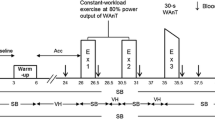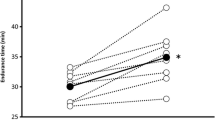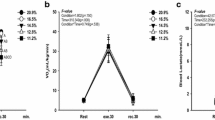Summary
The purpose of the study was to examine the influence of oxygen-breathing on maximal oxygen uptake (\(\dot V\)O2max) and submaximal endurance performance. Six young women and five men rode a cycle-ergometer while breathing compressed air (normoxia, NOX) or a 55% O2 in N2 mixture (hyperoxia, HOX). The\(\dot V\)O2max increased significantly by 12% (P<0.01) with HOX in the women but not in the men (+4%; nonsignificant). Maximal heart rate was also increased with HOX in the women but not in the men. Endurance time during work to -exhaustion at 80% of normoxic\(\dot V\)O2max was 41% longer in HOX than in NOX (P<0.025) with no significant difference between the men and the women. The variation among individuals was large. The oxygen uptake and respiratory quotient were not different in the two endurance tests, but pulmonary ventilation (\(\dot V\) E) and blood lactate concentration were lower in HOX than in NOX, especially during the latter part of the task. Plasma base deficit (BDpi) increased initially by 3.5 mmol · l−1 during HOX and then stabilized. In NOX, a continuous increase was seen and the change was more than twice as large. Relative to BDpl,\(\dot V\) E was higher in HOX than in NOX indicating a more efficient ventilatory compensation of the metabolic acidosis. The reduced ventilatory demand and lower metabolic acidosis in HOX in combination with lower relative exercise intensity may have contributed to the longer time to exhaustion. However, the pattern of individual variation suggested that other mechanisms were also involved.
Similar content being viewed by others
References
Adams RP, Welch HG (1980) Oxygen uptake, acid-base status, and performance with varied inspired oxygen fractions. J Appl Physiol 49:863–868
Aicken CC, Thomas RC (1977) An investigation of the ionic mechanism of intracellular pH regulation in mouse soleus muscle fibres. J Physiol (Lond) 273:295–316
Asmussen E, Nielsen M (1946) Studies on the regulation of respiration in heavy work. Acta Physiol Skand 12:171–188
Åstrand P-O, Cuddy TE, Saltin B, Stenberg J (1964) Cardiac output during submaximal and maximal work. J Appl Physiol 19:268–274
Bannister RG, Cunningham DJC (1954) The effects on the respiration and performance during exercise of adding oxygen to the inspired air. J Physiol (Lond) 125:118–137
Boutellier U, Piwko P (1989) The respiratory system as an endurance limiting factor. In: Hirvonen L, Timisjärvi J, Niiranen S, Leppäluoto J (eds) Proceedings of the International Union of Physiological Sciences 17, OY Liitto, Oulu, Finland, Abstract p 4580
Bye PTP, Farkas GA, Roussos C (1983) Respiratory factors limiting exercise. Annu Rev Physiol 45:439–451
Causon RC, Carruthers ME, Rodnight R (1981) Assay of plasma catecholamines by liquid chromatography with electrochemical detection. Anal Biochem 116:223–226
Ekblom B, Huot R, Stein RM, Thorstensson AT (1975) Effect of changes in arterial oxygen content on circulation and physical performance. J Appl Physiol 39:71–75
Forster HV, Dempsey JA, Thomson J, Vidruk E, doPico GA (1972) Estimation of arterial PO2, PCO2, pH and lactate from arterialized venous blood. J Appl Physiol 32:134–137
Froberg K, Pedersen PK (1984) Sex differences in endurance capacity and metabolic response to prolonged, heavy exercise. Eur J Appl Physiol 52:446–450
Graham TE, Pedersen PK, Saltin B (1987) Muscle and blood ammonia and lactate responses to prolonged exercise with hyperoxia. J Appl Physiol 63:1457–1462
Heintzelman MB, Chen H (1982) Exercise performance after ventilatory work. J Appl Physiol 52:1581–1585
Hogan MC, Cox RH, Welch HG (1983) Lactate accumulation during incremental exercise with varied inspired oxygen fractions. J Appl Physiol 55:1134–1140
Humpeler E, Amor H (1973) Sex differences in the oxygen affinity of hemoglobin. Pflügers Arch 343:151–156
Hughes RL, Clode M, Edward RHT, Goodwin TJ, Jones NL (1968) Effects of inspired O2 on cardiopulmonary and metabolic responses to exercise in man. J Appl Physiol 24:336–347
Jardim J, Farkas G, Prefaut C, Thomas D, Macklem PT, Roussos CH (1981) The failing respiratory muscles under normoxic and hypoxic conditions. Am Rev Respir Dis 124:274–279
Karlsson J, Saltin B (1970) Lactate, ATP, and CP in working muscles during exhaustive exercise in man. J Appl Physiol 29:598–602
Karlsson J, Saltin B (1971) Diet, muscle glycogen, and endurance performance. J Appl Physiol 31:203–206
Knudsen SE, Pedersen PK (1987) Effects of experimentally induced acid-base changes in humans on the physiological responses to exhaustive bicycle exercise at 80% of\(\dot V\)O2max. J Physiol (Lond) 390:243P
Martin BJ, Stager JM (1981) Ventilatory endurance in athletes and non-athletes. Med Sci Sports Exerc 13:21–26
Nielsen M, Hansen O (1937) Maximale körperliche Arbeit bei Atmung O2-reicher Luft. Skand Arch Physiol 36:37–59
Nygaard E, Andersen P, Nilsson P, Eriksson E, Kjessel T, Saltin B (1978) Glycogen depletion pattern and lactate accumulation in leg muscles during recreational downhill skiing. Eur J Appl Physiol 38:261–269
Pardy RL, Bye PTB (1985) Diaphragmatic fatique in normoxia and hyperoxia. J Appl Physiol 58:738–742
Paterson DJ, Pinnington H, Pearce AR, Morton AR (1987) Maximal exercise cardiorespiratory responses of men and women during acute exposure to hypoxia. Aviat Space Environ Med 58:243–247
Sjödin B, Svedenhag J (1985) Applied physiology of marathon running. Sports Med 2:83–99
Sjøgaard G, Adams RP, Saltin B (1985) Water and ion shifts in skeletal muscle of humans with intense dynamic knee extension. Am J Physiol 248 (Regulatory Integrative Comp Physiol):R190-R196
Stewart PA (1983) Modern quantitative acid-base chemistry. Can J Physiol Pharmacol 12:1444–1461
Sutton JR, Jones NL, Toews CJ (1981) Effect of pH on muscle glycolysis during exercise. Clin Sci 61:331–338
Welch HG (1982) Hyperoxia and human performance: a brief review. Med Sci Sports Exerc 14:253–262
Welch HG, Pedersen PK (1981) Measurement of metabolic rate in hyperoxia. J Appl Physiol 51:725–731
Wilson GD, Welch HG (1975) Effects of hyperoxic gas mixtures on exercise tolerance in man. Med Sci Sports 7:48–52
Author information
Authors and Affiliations
Rights and permissions
About this article
Cite this article
Plet, J., Pedersen, P.K., Jensen, F.B. et al. Increased working capacity with hyperoxia in humans. Europ. J. Appl. Physiol. 65, 171–177 (1992). https://doi.org/10.1007/BF00705076
Accepted:
Issue Date:
DOI: https://doi.org/10.1007/BF00705076




